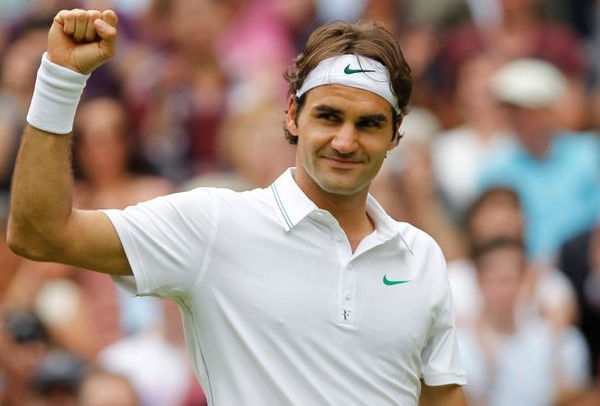

Greatness. Entire careers and lifetimes have been built and wasted in the pursuit of this elixir of life. Greatness guarantees immortality. But, how does one quantify greatness? How do you identify that the moment has come to mark a particular artist/sportsperson/era as great? Does greatness equal domination and annihilation? Is it the subversion of every rule/tactic that has preceded you? The ‘playing it my way’ way of doing things. Arguably, it’s a far tougher job to rank eras and to compare them.
Since the Open Era begun, tennis has undergone a sea change. In every way imagineable. It has gone from a sport being played by gentlemen in trousers to gladiators like Nadal lording over it.It went from a game being played by wooden racquets to alloyed racquets with a much larger contact area (though Borg did try with the wooden racquet on his comeback, but, nevermind).
ADVERTISEMENT
Article continues below this ad

The Bjorn Borg era was the one which gave the tennis world its first superstar in the ice cool Swede. The flowing locks, stone faced persona and the natural swagger only added to his charm. His major rivals back then were John McEnroe and Jimmy Connors, both Americans. But Borg’s reign at the top was like a shooting star,short lived, but it blinded all others into oblivion when it was there. What adds to the Swede’s legend is that his greatest year was also his last. Almost like a King’s last desperate attempt to hold onto his crumbling empire, was his legacy. Add to it that clay and grass are the two most varied surfaces, like chalk and cheese and Borg remains the only champion who truly mastered these two with 6 French Open and 5 Wimbledon titles. Connors was as dogged as they come, a razor sharp mouth but his descent had started with Borg’s ascension. McEnroe was the one who ended the Swede’s iron like grip on the tennis world, and in the process lost his greatest rival. It’s only fitting that 1980, Borg’s last great year, produced the Wimbledon Final that many consider to be the greatest tennis match ever played.

After a turbulent 1980s where a host of great players emerged amongst which were Becker, Edberg, Lendl etc, the Grand Slams kept changing hands with no clear winner. Albeit, the Edberg-Becker rivalry provided a nice little subplot and will go down as one of the great Wimbledon duels with 3 consecutive finals played at the All England Club. In the 90s, with Andre Agassi providing the perfect antithesis, the crown finally settled on Pete Sampras’ head. The American was terribly easy on his eye with the original big, booming serve, a forehand as powerful as the game had seen and the serve and volley game. It was only obvious that this sort of fast paced game lent itself to the quicker surfaces, with Sampras achieving ridiculous success at SW19, with 7 titles, 5 of which were in a row. His other 7 Grand Slams were won at Flushing Meadows(5) and the Rod Laver Arena. Much like innumerable serve and volley players who had come before him, it was the clay of Roland Garros that proved to be his Waterloo. Much like Brazil at Maracana 1950, it just wasn’t to be for him. Sampras retired, an unfulfilled dream left behind, the Slam that wasn’t to be. As the new Millenium rolled around, Pistol Pete faded away, and US Open 2002 was to be his swansong. He defied odds to reach the Final, where, he had his one last hurrah over Andre Agassi, his one true nemesis, the one rivalry that defied the 90s. Sampras won, an adoring home crowd cheering on.
Some things are just too perfect. You don’t write such scripts.
In 2001, Sampras was beaten in the 4th round of the Wimbledon by a young Swiss donning a bandana. It was a five-set marathon, the Swiss idolized Sampras. It was a certain Roger Federer and as had been a five-setter at US Open 1980, a match that had gone to the wire had to be, to symbolize the passing of the mantle from one generation to another. Federer lost in the next round but a legend was born. The next few years, he went on to establish a black hole of a legacy, an aura all encompassing, one that simply swallowed any and everything in its vicinity, no record, past or present escaping it.

Federer’s era, the early 00’s were the time when tennis was truly globalised, fans sprouting up everywhere and ATP events breaking new geographical barriers. Hawk Eye was introduced, technology became a more integral part of the game and with broader and more powerful racquets becoming the order of the day, the serve and volley style found no suitors, with powerful baseline play becoming the order of the day. The rush to the net approach was deemed too risky, a defensive style of play taking over, where you dictate play from the baseline with searing groundstrokes and top spin heavy shots, and wait for the opponent to make mistakes. The artistry gave way to graft. Beauty could now be overcome by brawn. The two-handed backhand became an almost integral part of the game with grunts flying all around. Apart from athleticism, endurance too was needed. This was like Bjorn Borg all over again. Amidst all this, Federer stood tall, an enigma, an anomaly, inverting the rulebook, still favouring the serve and volley style, the always elegant one handed backhand and the fluidic service motion. A force of nature. It was like watching a maestro from a world not our own, at work. Exuding charm and grace, the living embodiment of the metro-sexual 21st century male. It was almost like before Federer was, Wimbledon waited for him. The ultimate prize awaiting its ultimate practitioner.

While Federer was establishing an example that’ll be awed at for generations to come, Rafael Nadal was constructing his own legend, bit by bit, Slam by Slam. Here was a clay expert like the world had never seen. A player so dominant, it almost felt like he could win the French Open while doing whatever was his idea of not giving a damn. Eating burritos, going for a swim, practicing freestyle soccer, anything. Tennis in the first decade of the new millennium seems like a dichotomy, a choice between two exponents of the craft as removed from each other as could be. Some say that Nadal was fortuitous to have played in perhaps the weakest clay era of all time. When history will look back at him, it’ll judge him much more kindly, a man who lost only once in 10 years in Paris. And that one year is the one that put Federer in the most esteemed company, the list of players to have conquered all four Slams. The Career Grand Slam. He lapped up the one year Nadal slipped. The last citadel had fallen, the final frontier conquered, the mental demons lay slain. It was ironic justice that in an age where you could study your opponent’s game to such an extent that it’s almost possible to predict his next move, we had two players who pushed the lines of invincibility like never before. The man beats the machine.
ADVERTISEMENT
Article continues below this ad

ADVERTISEMENT
Article continues below this ad
The mantle of the both of these has passed onto Novak Djokovic who is a strange amalgamation of everything. A player of all surfaces and seasons, a player with no apparent weaknesses yet a player who still can’t claim absolute mastery over any Slam/Surface. Of all the men who went onto achieve tennis immortality, Djokovic is the one who came through the toughest circumstances, practicing in empty swimming pools, in his hometown as war ravaged through the Balkans. It brought about that indomitable warrior spirit that is ingrained in his DNA, the one that propels him like a marathon runner in long contests. The never say die spirit. It’s the warrior in him that is egged on when people root for his opponents. Growing up in a Civil War torn region also instilled a fierce sense of patriotism in him, a sense of always playing for his country, his land, his people.
These eras have sharp contrasts and each have been lead by a different champion and different changes to the way the sport is played, viewed, consumed. It’s impossible to select which era was the greatest though many regard the latter part of the 2000s as the Golden Age of tennis. The Roger-Rafa rivalry and the emergence of Novak Djokovic, of whom, the world is yet to see a lot. With how the sport was played evolving at such a fast rate, this era indeed packs a wallop in the contention for the greatest era of them all.
ADVERTISEMENT
ADVERTISEMENT
ADVERTISEMENT
ADVERTISEMENT

